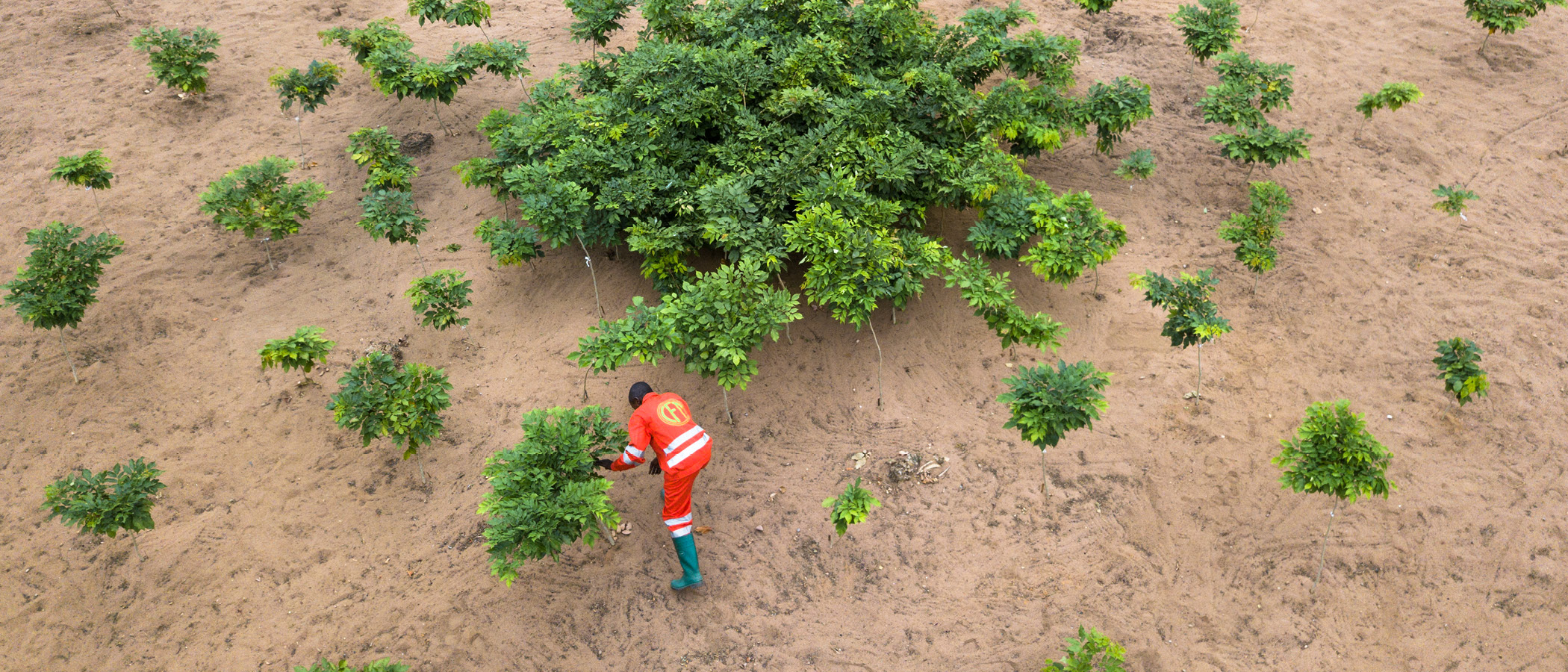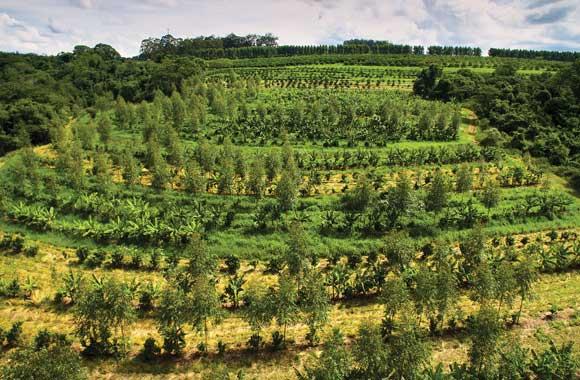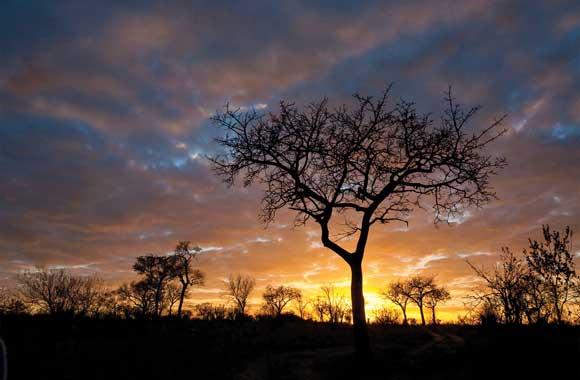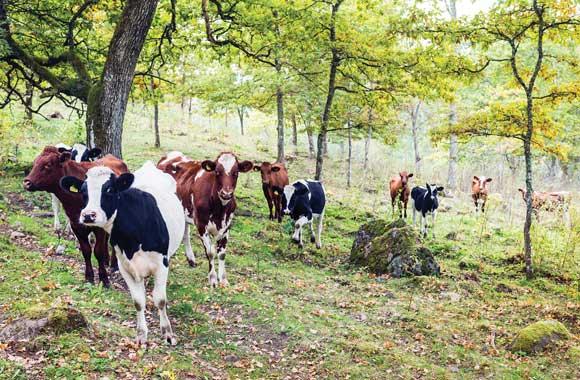Tropical Forest Restoration
Many tropical forests have undergone clearing, fragmentation, degradation, or depletion of biodiversity. Restoring these forests restores their ability to sequester carbon.
Reduced/Sequestered
2020–2050
Impact
Using existing and estimated commitments from the Bonn Challenge and New York Declaration on Forests, we assume that 161.36–230.77 million hectares of degraded land in the tropics could be restored to forest. Natural regrowth could sequester 1.4 metric tons of carbon dioxide equivalent greenhouse gases per acre annually, for a total of 54.45–85.14 gigatons by 2050.
Introduction
In recent decades, tropical forests have suffered extensive clearing, fragmentation, degradation, and depletion of biodiversity. Tropical forest trees, other vegetation, soil, and leaf litter absorb and hold carbon. Restoration is widely considered to offer substantial climate change mitigation opportunities, if conducted at large scales.
Project Drawdown’s Tropical Forest Restoration solution involves the restoration and protection of tropical-climate forests. This solution replaces degraded forest in the tropics.
The specific mechanics of restoration vary. The simplest scenario is to release land from nonforest use, such as growing crops or damming a valley, and let a young forest rise up on its own. Protective measures can keep pressures such as fire, erosion, or grazing at bay. Other techniques are more intensive, such as cultivating and planting native seedlings and removing invasive species to accelerate natural ecological processes. Tropical forest regrowth is often rapid, resulting in impressive rates of carbon sequestration.
The Tropical Forest Restoration solution models natural regeneration of tropical forests on degraded lands. This has the benefit of low cost. We assume that forest regrowth will be legally protected so it will not be cleared or degraded again.
Natural regeneration also offers co-benefits that make it an appealing option, including biodiversity conservation, watershed protection, soil protection, resilience to pests and disease, food, medicine, fiber, and places to live, adventure, and worship.
Methodology
Total Land Area
To evaluate the extent to which a Food, Agriculture, and Land Use sector solution can reduce greenhouse gas emissions and sequester carbon, we need to identify the total land area available for that solution. To avoid double counting, we use an integration model that allocates land area among all of the sector’s solutions. This involves two steps. First, we classify the global land area into agro-ecological zones (AEZs) based on the land cover, soil quality, and slope and assign AEZs to different thermal moisture regimes. We then classify the AEZs into “degraded” and “nondegraded.” Second, we allocate the solutions to AEZs, with the solution most suited to a given AEZ or sets of AEZs assigned first, followed by the second-most-suited solution, and so on. Because it’s hard to predict future changes, we assume the total land area remains constant. Total land areas represent both the implementation and functional unit.
We allocated 287 million hectares of degraded tropical forests for tropical forest restoration. We set current adoption (the amount of functional demand supplied in 2014) at 0 hectares because forests that have already been restored are accounted for as existing forest in our Agro-Ecological Zone model.
We calculated future restoration of tropical forests using targets from the New York Declaration of Forests, which commits to reforesting 350 million hectares by 2030 (United Nations, 2014) and estimates from the World Resources Institute, which estimate 304 million hectares of land are available for wide-scale restoration.
Adoption Scenarios
We developed 10 custom adoption scenarios based on: 1) current restoration commitments to date; 2) potential future commitments; 3) the proportion of committed land restored to intact forest; and 4) the year commitments are realized (2030, 2045, or 2060).
We calculated impacts of increased adoption of tropical forest restoration from 2020 to 2050 by comparing two scenarios with a reference scenario in which the market share was fixed at current levels.
- Scenario 1: 161.36 million hectares are restored (56 percent of the total available land area).
- Scenario 2: Based on a more aggressive adoption approach with peak adoption by 2030 or later, 230.77 million hectares of degraded tropical forest (80 percent of the total available land area).
Sequestration Model
We set sequestration rates at 4.4 metric tons of carbon per hectare per year, including above-ground biomass and roots, but not soil organic carbon. We based this on meta-analysis of 18 data points from 10 sources. Data on soil carbon sequestration were unavailable.
Financial Model
We assumed that any costs (e.g., carbon payments or payment for ecosystem services) would be borne at a government or nongovernmental organization (NGO) level. Project Drawdown Food, Agriculture, and Land Use sector solutions only model costs that are incurred at the landowner or manager level.
Integration
Project Drawdown’s Agro-Ecological Zone model allocates current and projected adoption of solutions to forest, grassland, rain-fed cropland, irrigated cropland, arid, and arctic areas. Tropical Forest Restoration is the highest-priority solution for degraded tropical forestland.
Results
Scenario 1 sequestered 54.45 gigatons of carbon dioxide equivalent emissions by 2050. We did not model financial impacts.
Scenario 2 sequestered 85.14 gigatons of carbon dioxide equivalent emissions by 2050.
Discussion
Benchmarks
Griscom et al. (2017) calculated 2.7–17.9 gigatons of carbon dioxide equivalent per year in 2030 for “reforestation” in temperate, boreal, and tropical forests. Our model shows 1.7–2.9 gigatons of carbon dioxide equivalent emissions per year by 2030 for tropical forest restoration and 0.6–0.9 for temperate forest restoration, for a combined 2.3–3.8 gigatons of carbon dioxide-equivalent emissions per year in 2030.
As more data on soil carbon sequestration in tropical forest restoration become available, the sequestration rate of this solution, and thus its mitigation impact, will likely increase. Inclusion of economic impacts (e.g., costs to governments and NGOs) would be a valuable addition to future updates. As more benchmarks become available, they should be included in the study as well.
Conclusions
We consider tropical forest restoration to be an extremely high priority, given its massive sequestration potential and numerous co-benefits. We assume that the new forests will be legally protected, as in the Forest Protection solution. Reduction of land demand for food helps ease pressure on these new forests. Solutions such as Family Planning and Education, Plant-Rich Diets, and Reduced Food Waste reduce demand. Agroecological intensification due to increased yields from solutions such as Conservation Agriculture and Silvopasture also makes room for these new forests. Abandoned Farmland Restoration helps make land available by bringing degraded farmland back into production.
References
Griscolm, B. W., Adams, J., Ellis, P. W., Lomax, G., Miteva, D. A., Schlesinger, W. H., Shock, D., Siikamäki, J. V., Smith, P., Woodbury, P., Zganjar, C., Blackman, A., Campari, J., Conant, R. T., Delgado, C., Elias, P., Gopalakrishna, T., Hamsik, M. R., Herrero, M., Kiesecker, J., Landis, E., Laestadius, L., Leavitt, S. M., Minnemeyer, S., Polasky, S., Potapov, P., Putz, F. E., Sanderman, G., Silvius, M., Wollenberg, E., Fargione, J. (2017). Natural Climate Solutions. Proceedings of the National Academy of Sciences, 114(44) 11645-11650. DOI: 10.1073/pnas.1710465114
United Nations (2014). Climate Change 2014 Mitigation of Climate Change: Working Group III Contribution to the Fifth Assessment Report of the Intergovernmental Panel on Climate Change. URL: http://ebooks.cambridge.org/ref/id/CBO9781107415416
What You Can Do
If you manage development funds, consider that tropical forest restoration can benefit people, reduce biodiversity loss, and reduce climate risk at the same time.
Hold the companies that make your food and beverages, or in which you are invested, responsible for protecting existing tropical forests and supporting the restoration of degraded ones.
- Expand your knowledge by exploring another Drawdown solution.
Co-benefits
Tropical forests support pollinators that in turn support pollinator-dependent agriculture, providing food for local people.
Tropical forests retain nitrogen in watersheds, benefiting downstream rivers and lakes.
Tropical forest protection helps preserve and safeguard biodiversity in Key Biodiversity Areas.











